Important
While BuildOps does not currently offer a HVAC flat rate pricing software, we’re always looking into new and exciting tools and technology that are moving the industry forward, which is why we’re discussing the subject here.
HVAC work doesn't leave much room for guesswork. When you're running back-to-back calls, pricing delays can slow the whole crew down. That’s where HVAC flat rate pricing software makes a difference—giving your team fast, reliable prices without crunching numbers on-site. But not all tools fit the way commercial service teams actually work.
This guide breaks down what to look for, how contractors are using flat rate systems today, and why some platforms go beyond simple price books. If you’re part of the HVAC industry, understanding how flat rate software shapes quoting, invoicing, and job execution can keep your business moving. Here’s what we’ll cover:
- Choosing the right HVAC flat rate pricing software for your needs
- Common pricing models HVAC contractors actually use
- Where flat rate pricing can fall short in HVAC work
- 5 key features to watch for in HVAC flat rate pricing software
- 7 best HVAC flat rate pricing software platforms
- 6 benefits of using flat rate pricing tools in HVAC
- 4 important FAQs about HVAC flat rate pricing software answered
Before we jump into product breakdowns, it’s worth taking a step back. Your pricing system needs to keep up. So let’s start with how to evaluate HVAC flat rate pricing software in a way that matches how your crew actually works — not just what looks good in a demo.
Choosing the right HVAC flat rate pricing software for your needs
Inefficient pricing software slows down HVAC technicians with complicated quotes and uncertainty. Flat rate pricing software should streamline on-the-spot pricing, preventing technicians from struggling with calculations or needing to contact the office during jobs. However, some platforms aren't designed for real-world HVAC workflows and can add unnecessary steps.
So how do you find a flat rate pricing HVAC software that actually supports the way your crew runs? This section lays out the key questions contractors should ask before committing to a platform—whether you're quoting a simple tune-up or building out estimates for large commercial maintenance jobs.
Here’s how to frame your thinking as you look for a tool that backs your crew in the field:
- Workflow alignment - Does the software match how your techs and office staff currently handle quotes, scheduling, and billing? Will it plug into your existing tools like dispatch boards or accounting platforms without a heavy lift? Can it handle both emergency service calls and long-haul commercial contracts without falling apart?
- Field usability - Is the interface simple enough for techs to use from the truck—or even a rooftop? Can they pull up rates, adjust line items, and show customers pricing on the fly without needing help? Does mobile access stay reliable even in spotty signal areas?
- Operational flexibility - Will the system keep pace as you add trucks, techs, or new service areas? Can multiple users access the same price books and job data without locking each other out? Are role permissions customizable so only certain team members can change rates or edit quotes?
- Vendor trust and reliability - What’s the plan when something breaks—can you talk to a real person? How often does the vendor push updates to reflect HVAC code changes or new service standards? Does the company have a track record with HVAC contractors, not just general service trades?
- Features - Can it support tiered pricing or custom service bundles that reflect how you actually price work? Are there upsell tools built in to help techs boost ticket value during service calls? Does it sync seamlessly with estimates, work orders, and invoices without needing double entry?
Now that you’ve locked in the big-picture questions, let’s unpack how HVAC contractors are structuring their pricing—and where flat rate models deliver or fall short.
Common pricing models HVAC contractors actually use
Before locking in a flat rate system, it’s worth taking a step back. How you price jobs can shape everything—from how fast techs move in the field to how confident customers feel signing off. HVAC work covers everything from routine maintenance to emergency system failures, so choosing a model that matches your mix of jobs isn’t just smart—it’s necessary.
Here’s a breakdown of how HVAC contractors are structuring pricing today:
- Flat rate pricing: This model offers a fixed cost for a defined job—no surprises, no hourly math. It’s a go-to for service calls where the scope is clear. Think coil cleanings, seasonal tune-ups, or compressor replacements. The benefit? Faster approvals and less back-and-forth. HVAC flat rate pricing software works best in this model, helping techs quote with confidence and speed without making phone calls mid-job.
- Time and materials: Some jobs are just unpredictable—like tracing intermittent cooling issues or working on an unfamiliar system with parts that may be discontinued. Time and materials lets you charge for actual hours worked and materials used. It gives flexibility on custom or complex jobs, but it’s harder to standardize. Customers might balk at the running total if expectations aren’t set clearly. And for teams without strong tracking tools, this model can create invoicing headaches.
- Tiered or bundled pricing: This setup gives customers options: basic, advanced, premium. It’s ideal when upselling warranties, efficiency upgrades, or service plans. It also helps techs present value in a structured way—especially if your work includes both installs and long-term maintenance. Some flat rate pricing HVAC software includes tier templates to make these conversations easier in the field.
Each model solves a different challenge. But if your techs are quoting on the spot, juggling multiple stops, or working with dispatch to stay on track, flat rate pricing backed by HVAC-specific software makes that process smoother, cleaner, and easier to scale.
Where flat rate pricing can fall short in HVAC work
Flat rate pricing can streamline quoting for straightforward HVAC tasks—thermostat swaps, seasonal maintenance, or standard filter replacements. But HVAC service isn’t always predictable. A call that starts with a suspected refrigerant leak can quickly escalate into diagnosing faulty wiring, aging coils, or compressor failure. Fixed pricing doesn’t adapt when the scope shifts, and techs end up forced to choose between sticking to a pre-set rate or delaying the job to get a new quote approved.
Most HVAC flat rate pricing software is structured around standardized menus that work for routine services but struggle under variable conditions. Commercial contractors, in particular, face challenges when jobs involve complex equipment, phased replacements, or building-specific constraints. Residential teams also run into issues when systems have been pieced together over the years, making no two calls the same. If the software can’t handle on-the-fly changes, techs are stuck improvising—and invoicing becomes inconsistent.
Another issue is integration. Flat rate tools often operate in isolation from dispatch, asset tracking, or job costing. That disconnect adds work for the back office and increases the risk of pricing errors. HVAC teams that need to link quoting to parts inventory, labor tracking, or equipment history require systems that go beyond static rates. That’s why many companies adopt field service management platforms that centralize operations—linking pricing with real-time data, job updates, and customer records.
Flat rate works for what’s repeatable. But HVAC work spans a range of conditions, building types, and system complexities. Relying only on fixed pricing limits your ability to bill accurately, adjust on-site, or scale across different job types. For contractors managing commercial service agreements, legacy system upgrades, or even just busy seasonal spikes, flexibility in pricing isn't optional—it’s operational.
5 key features to watch for in HVAC flat rate pricing software
HVAC service moves fast, and quoting needs to move with it. The best HVAC flat rate pricing software doesn’t just build a price book—it connects quoting, dispatch, and invoicing into one workflow. These five features are what actually make a difference when your techs are out in the field and every minute counts.
1. Real-time scheduling and job management
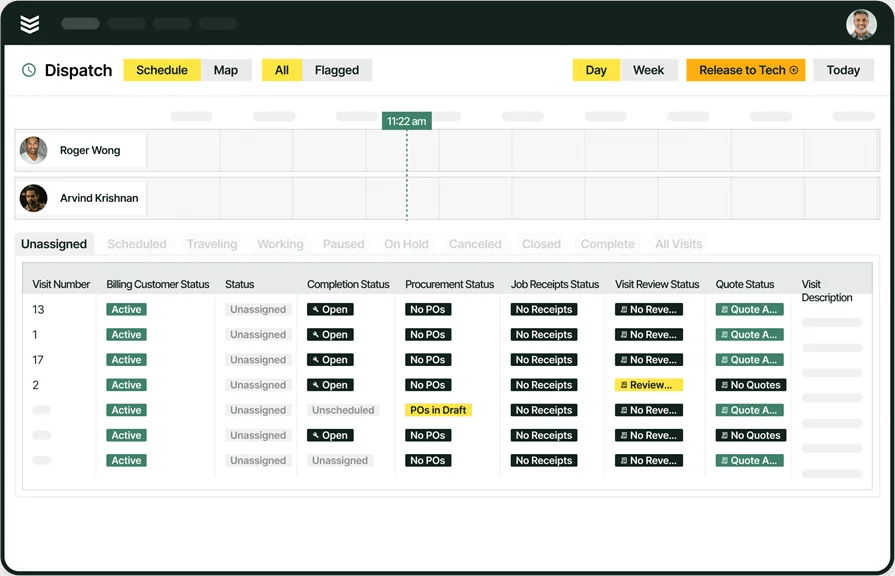
Scheduling needs to tie directly into pricing and invoicing. HVAC flat rate pricing software that includes HVAC scheduling software helps dispatchers assign jobs with pre-loaded flat rates, so techs can act without delay and billing stays clean. Let’s say your tech wraps a service call early. There’s a nearby repair request already prepped in the system with a flat rate attached. Instead of wasting time or calling in, dispatch drops the new job into their queue. The flat rate is ready, the job is accepted, and they’re on-site within the hour.
2. Dispatch board with price-locked work orders

A connected HVAC field service dispatch platform lets teams preload flat rate pricing into work orders before the truck even rolls out. This helps reduce miscommunication between what’s quoted and what’s delivered. Imagine, during a busy cooling season, a tech heads to a basic thermostat replacement. On arrival, it’s clearly a wiring issue. Thanks to the price-locked dispatch setup, they’ve already got alternate flat rates available. They switch tasks, update the invoice, and move forward—without halting the job.
3. Mobile field access to flat rate pricing
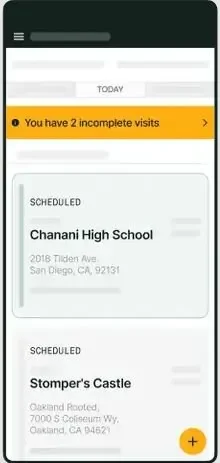
Flat rate pricing tools must be mobile-first. A technician mobile app gives techs access to service rates, upsell options, and customer history directly from their phones or tablets—no calls to the office required. For example, in the middle of a furnace repair, a tech spots a cracked heat exchanger. Instead of guessing the cost, they pull up the pre-set replacement rate, show it to the customer, and get approval—all while still in the mechanical room.
4. Integrated time tracking tied to flat rate pricing
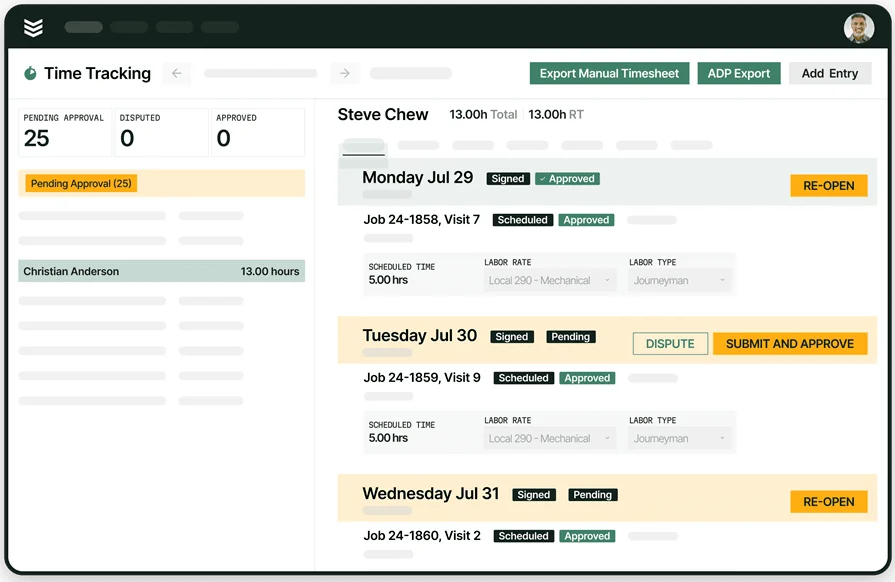
Even with fixed pricing, tracking actual time spent on jobs helps HVAC teams catch profit leaks. Time tracking tools tied to job data show where the hours go and whether flat rates need adjusting. Let’s say your crew has been underquoting ductless installs. With job-by-job labor data, it becomes clear those tasks regularly run over. You update the flat rate to reflect true labor, protect your margin, and avoid repeated callbacks about delays.
5. Built-in digital payments at the point of service
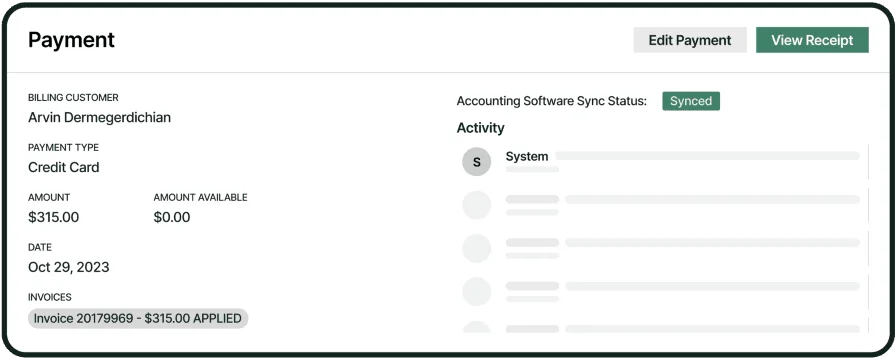
Closing out a job means getting paid fast. HVAC flat rate pricing software that syncs with digital payment tools lets techs invoice and collect on-site—no extra paperwork, no billing lag. For instance, after replacing a condenser unit, your tech wraps the job, opens the invoice, and hands the customer a tablet. They tap their card, payment is confirmed, and everything syncs back to the system—done before they even leave the driveway.

Explore our quoting product
Streamline pricing and bidding so you land more jobs—and can increase profits.
Other notable features to look for in HVAC flat rate pricing software
In addition to the core functionality, certain features can help HVAC businesses refine how they quote, track, and maintain customer relationships. These aren’t required to get started, but they bring added efficiency when your operations start scaling.
- Customer relationship management (CRM) - A built-in CRM software keeps all client details—equipment history, past services, and preferences—in one place. When paired with flat rate pricing, it helps techs and office staff quote based on service history, tailor upsells, and avoid redundant questions during follow-ups.
- Reporting and performance analytics - Reporting tools break down what’s getting quoted most, where jobs are dragging past flat rate expectations, and which tasks are losing margin. This data helps fine-tune your price book over time, spot underperforming services, and adjust labor estimates accurately.
- Service agreement tracking For HVAC companies offering routine maintenance or premium service plans, service agreement management allows those recurring jobs to be priced under consistent flat rates. It simplifies billing, supports contract renewal, and ties everything back to your pricing catalog.
These features aren’t required to run HVAC flat rate pricing software, but they add a serious edge when you're ready to dial in performance across scheduling, quoting, and field execution. Let me know when you want to move forward with the next section.
7 best HVAC flat rate pricing software platforms
Flat rate tools aren’t one-size-fits-all—especially in HVAC. Some contractors focus on high-volume residential calls, while others manage multi-phase commercial projects with complex quoting needs. The best HVAC flat rate pricing software depends on how your team operates in the field, how you quote work, and how tightly pricing needs to connect with the rest of your system. Here's a look at seven top platforms, who they're best suited for, and what to watch for before making a decision.
1. Best for commercial HVAC: BuildOps
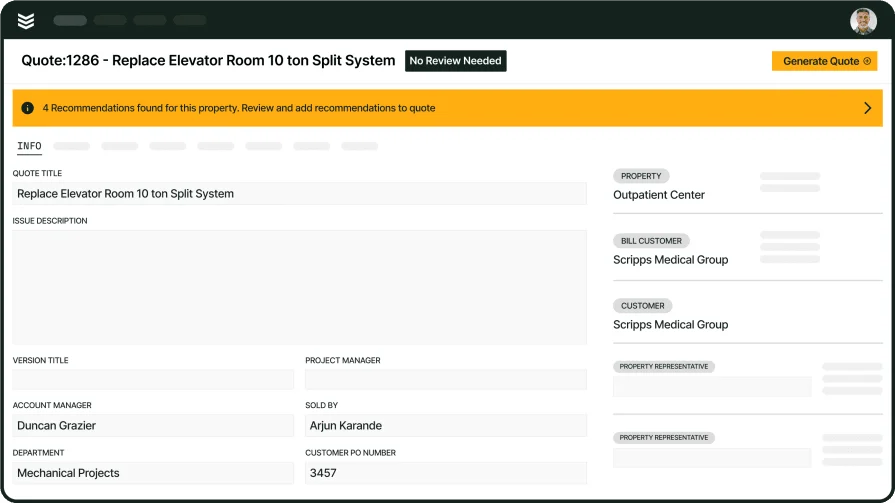
BuildOps was built for commercial HVAC contractors who need pricing to connect with the rest of the job. Flat rate pricing can be embedded directly into quotes or service workflows, keeping pricing consistent while still supporting complex estimates. Whether you’re managing reactive service calls or planned maintenance, BuildOps ties quoting, dispatching, invoicing, and field performance together—so no numbers fall through the cracks.
How pricing works: BuildOps offers custom pricing based on business size and operations. Weekly live demos are available for teams that want to see how the platform fits their process.
Features beyond pricing: Technician mobile tools, advanced dispatch, job costing, asset tracking, and automated workflows—all under one roof. Flat rates sync with real-time job data to eliminate rework and improve billing accuracy.
What sets it apart for commercial HVAC: BuildOps gives contractors visibility across jobs, crews, and customer history—while still allowing for quick-turn flat rate work.
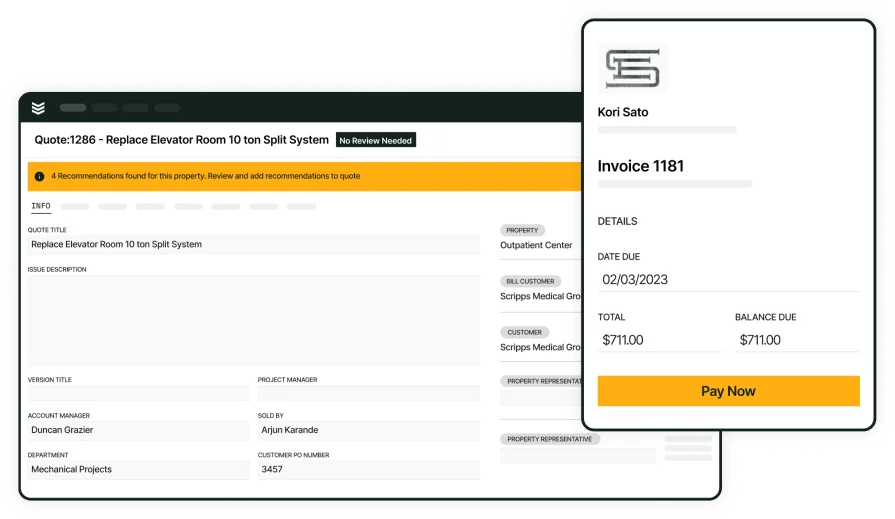
Give BuildOps a Try
Streamline everything from quoting to collections—so you can improve cash flow.
2. Best for residential HVAC: Housecall Pro

Image Source: Housecall Pro
Housecall Pro offers a mobile-first tool for HVAC service businesses that quote and invoice on-site. Techs can generate flat rate quotes, collect digital signatures, and get paid without returning to the office. It’s fast, lightweight, and built for high-volume residential work. However, it may not be the best fit for contractors who need detailed job costing or dispatching across multiple teams.
How pricing works: Flat rate pricing tools are included in all subscription tiers, starting at roughly $59/month.
Features beyond pricing: Review generation, GPS tracking, text-based customer updates, and a strong mobile experience.
What sets it apart for residential service: Designed to help techs quote and close jobs in one visit, especially for HVAC companies focused on single-family homes or light commercial.
3. Best for general contractors managing HVAC: Aptora
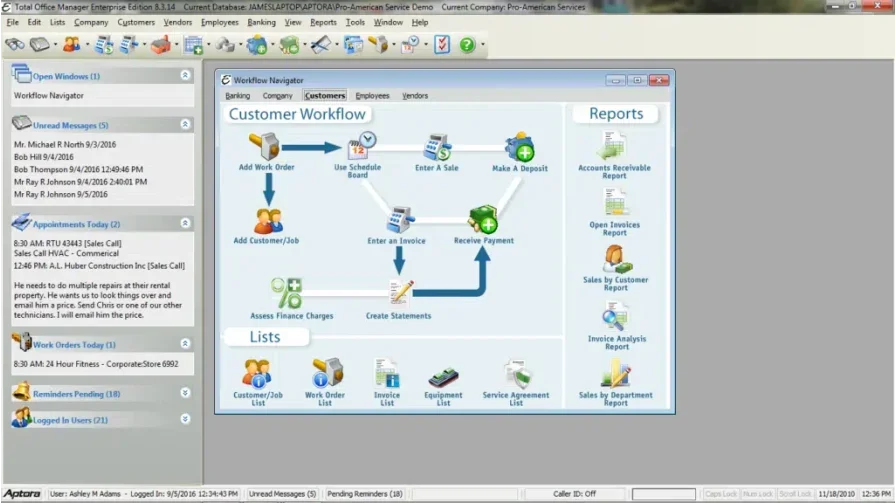
Image Source: Aptora
Aptora offers a robust office management platform that includes flat rate pricing, dispatch, payroll, inventory, and more. HVAC teams can build customized price books, apply tiered pricing, and manage field operations alongside other trades. The system is designed for contractors who want to manage both service and project-based work in one place. However, it may not be ideal for companies looking for a clean mobile interface or a tool that’s easy to ramp up without IT support.
How pricing works: Pricing is quote-based depending on deployment type (cloud or on-premise).
Features beyond pricing: Payroll, service agreements, full accounting, and dispatching are all bundled into the system.
What sets it apart for general contractors: Strong for multi-trade businesses or HVAC contractors who also manage electrical or plumbing under the same umbrella.
4. Best for independent HVAC contractors: Service Fusion
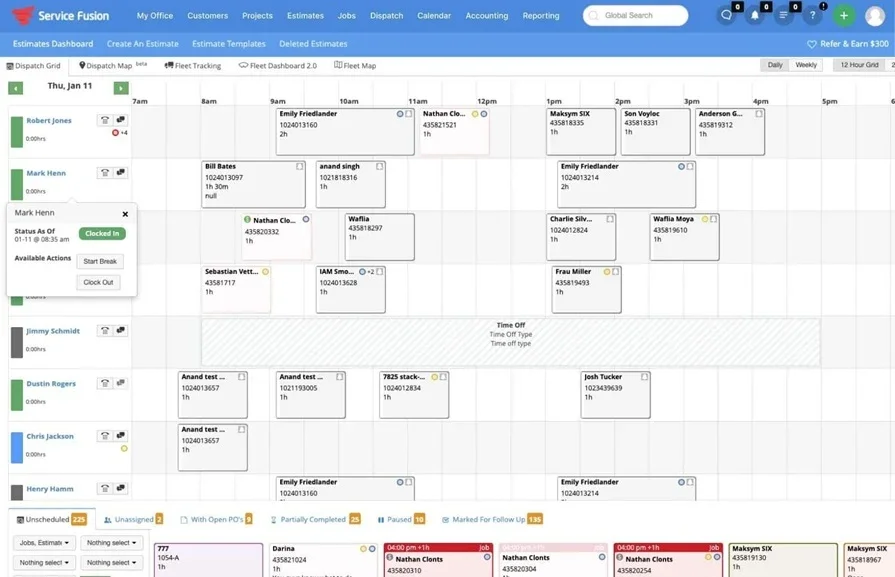
Image Source: Service Fusion
Service Fusion is built for small HVAC businesses that want simple flat rate pricing without a steep learning curve. It includes price books, digital invoicing, work orders, and customer management—all in one accessible platform. It’s a practical option for independent contractors or small teams that need to move fast. Though it still lacks the depth needed for larger operations or HVAC companies that rely on complex workflows and enterprise reporting.
How pricing works: Subscription starts at around $125/month and includes unlimited users.
Features beyond pricing: GPS tracking, VoIP tools, QuickBooks sync, and basic reporting.
What sets it apart for small HVAC teams: Unlimited user pricing and an intuitive interface make it well-suited for smaller teams that want control without overhead.
5. Best for growing HVAC businesses: ServiceTitan
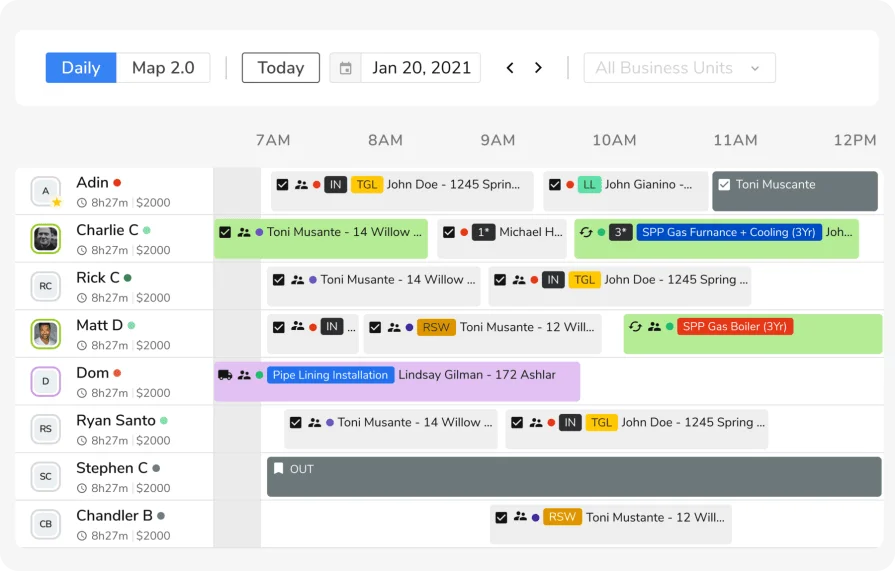
Image Source: ServiceTitan
ServiceTitan is a well-known field service platform that offers flat rate pricing alongside tools for dispatch, marketing, reporting, and customer communication. HVAC companies can build detailed price books, bundle services, and sync quotes with invoices in real-time. It’s built to support multi-location businesses and contractors who want to scale operations with a deeper tech stack. However, it may not be the best option for shops that need faster onboarding or are looking for a more budget-conscious tool.
How pricing works: Plans start around $398/month for office users, with additional costs for technician licenses and add-ons.
Features beyond pricing: Marketing automation, call tracking, field invoicing, custom reports, and mobile access.
What sets it apart for growing HVAC contractors: Designed for scaling field teams with tools that connect quoting, tracking, and billing into one ecosystem.
6. Best for upselling flat rate services: The New Flat Rate
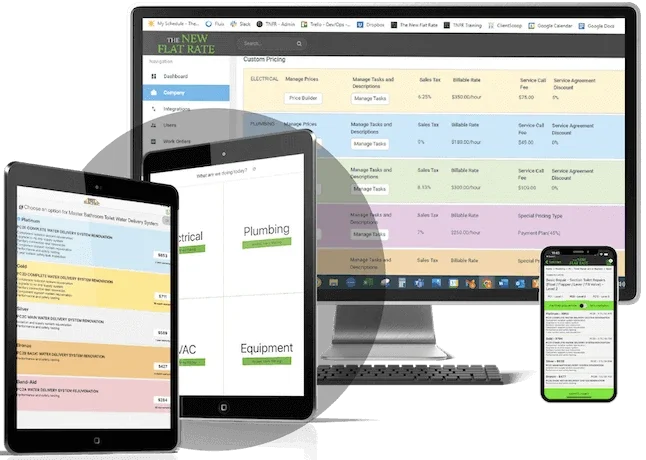
Image Source: The New Flat Rate
The New Flat Rate is a sales-focused pricing platform built around visual flat rate menus. It uses a tiered pricing model—good, better, best—to help HVAC techs present options that drive ticket value. It’s especially useful for residential service teams that want to standardize upsells and improve close rates without building pricing structures from scratch. However, it doesn’t offer full operational tools like dispatch, scheduling, or inventory—so it’s best used as a pricing and sales layer, not a standalone platform.
How pricing works: Plans start at $249/month and include access to pricing templates and upsell tools.
Features beyond pricing: Sales tracking, presentation coaching, basic reporting, and financing integrations.
What sets it apart for HVAC upselling: Built to help techs present pricing in the field with visual tools that guide customers toward higher-value options.
7. Best for lightweight field teams: FieldEdge

Image Source: FieldEdge
FieldEdge delivers a streamlined flat rate pricing solution aimed at HVAC contractors who need clean quoting tools without the overhead of a complex system. It supports mobile access to price books, customer history, and invoicing—ideal for teams that prioritize speed in the field. This setup works well for lean operations that don’t require advanced customization or enterprise-level functionality. It may not be the best fit for HVAC businesses managing large crews or multi-layered workflows.
How pricing works: Pricing generally starts around $125–$150/month per user, depending on the feature set.
Features beyond pricing: QuickBooks sync, dispatching, time tracking, customer profiles, and job history.
What sets it apart for small teams: FieldEdge focuses on fast quoting and simplicity, which suits HVAC contractors looking for a tool that supports efficient fieldwork without added complexity.
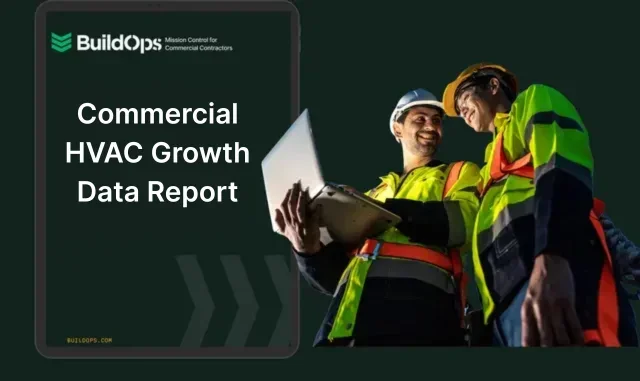
Increase profits with BuildOps
Gain insights into how HVAC pros grow and scale their operations.
6 benefits of using flat rate pricing tools in HVAC
Flat rate pricing can be a smart move for HVAC contractors who need speed and consistency during service calls. It cuts down delays, standardizes quoting, and helps techs stay focused on the job. But when you're handling a range of job types—like custom installs, commercial work, or multi-system maintenance—flat rate works best when paired with a tool that allows flexibility. Here's how flat rate pricing tools can still offer strong value across your operation.
1. Faster quote-to-cash turnaround
With flat rate pricing built into your system, techs move from quote to payment without pausing for approvals or adjustments. The billing process becomes faster and more predictable—especially when the quote connects cleanly to the final invoice. This kind of streamlined billing is a core focus in many HVAC invoicing workflows where reducing turnaround time is tied directly to revenue consistency.
2. Consistent customer experience across the board
Standard pricing means customers see the same numbers no matter who shows up. It eliminates back-and-forth during the visit and makes your team look aligned. But not all HVAC jobs are alike—contractors often benefit from platforms that support both flat and adjustable pricing, similar to how flexibility is built into HVAC estimating systems for complex or multi-zone jobs.
3. Easier onboarding for new technicians
Flat rate tools give newer techs a reliable starting point. With predefined prices and service lists, they can quote confidently without constant check-ins. This simplifies training and reduces early quoting mistakes. Many HVAC companies pair these tools with broader systems that evolve as techs gain experience, rather than locking them into rigid templates.
4. Fewer customer disputes and callbacks
Flat rate quotes create transparency early in the visit, making it easier to avoid pricing disagreements after the job wraps. Everything is documented, and the customer knows what they’re signing off on. In HVAC fieldwork, where labor, parts, and approvals all move quickly, tools that tie pricing directly into dispatch and job records—like those used in HVAC field service management platforms—help ensure billing matches the work performed.
5. Clearer sales opportunities
Having fixed pricing for services also helps techs suggest add-ons with confidence. Instead of guessing or offering vague ranges, they can show upgrade options tied to real prices. But in HVAC, selling add-ons often requires a more dynamic approach—especially for maintenance plans or system replacements—similar to what’s detailed in HVAC-focused sales tools designed to support in-field upselling.
6. Simplified work order tracking
Flat rate systems help align what's quoted, what's done, and what's billed—all within the same job record. It reduces manual entry and improves invoice accuracy. HVAC contractors handling multiple visits or projects benefit most when flat rate pricing is linked to broader work order management systems that keep tasks, pricing, and technician notes in sync.
4 important FAQs about HVAC flat rate pricing software answered
Whether you're exploring HVAC flat rate pricing software for the first time or trying to figure out if it still fits the way your business runs, these FAQs cover the biggest questions contractors ask. From how it works to whether it’s worth the cost, here’s what you need to know.
1. What is HVAC flat rate pricing software?
HVAC flat rate pricing software helps contractors quote fixed prices for common services like tune-ups, filter replacements, or thermostat installs—without needing to calculate labor and materials on the fly. It standardizes pricing across your team, improving speed and clarity during service calls.
These platforms are built to support quoting directly from a digital price book, often with built-in invoicing and mobile access. It’s helpful for residential and repeatable work, but less flexible for contractors handling variable labor or large commercial installs.
2. Is HVAC flat rate pricing software worth the cost?
That depends on how your HVAC business is structured, how many service calls you run, and how standardized your job types are. For many contractors, flat rate software pays off when used for high-frequency residential work. However, it's becoming more common to lean toward custom or tiered pricing models for flexibility.
- If your techs run similar jobs day in and day out, flat rate pricing can shorten quote time and avoid billing errors.
- If you’re dealing with commercial clients or custom install work, flat rates alone may be too rigid.
- Businesses that want a mix of speed and flexibility often look for systems that combine flat rates with adjustable pricing based on scope.
3. How does flat rate pricing software for HVAC work?
Flat rate pricing software usually starts with a preloaded or customized price book. Techs access it from a mobile device in the field, select the service task, and present the rate to the customer—no back-and-forth with the office. Once approved, the task syncs with the invoice, and the payment can be collected on-site or sent digitally. The goal is to remove friction from quoting while keeping prices consistent across the team. Some platforms also support alternative rates or upgrades, making them more adaptable in the field.
4. Best practices for implementing a flat rate pricing software for HVAC
Rolling out a flat rate pricing system across your HVAC business takes more than uploading a list of prices. To make it stick and actually benefit your crew, follow these best practices:
- Audit your most common jobs and identify pricing gaps or inconsistencies.
- Build a clear pricing catalog organized by service type and scope.
- Avoid overloading your list—start with core services and expand as needed.
- Involve your techs in reviewing the price book so it reflects field realities.
- Roll out the system in phases, starting with residential or high-frequency jobs.
- Train both techs and office staff on how pricing flows into quotes and invoices.
- Make sure your techs can access pricing tools from the field, even with spotty signal.
- Set permissions so only managers or admins can update rates.
- Tie the pricing system into your dispatch, job tracking, and invoicing tools for accuracy.
- Review data after implementation—track quote time, job margins, and adjustments to improve over time.
Flat rate pricing can bring structure to HVAC service calls—cutting down on quoting time, building trust with customers, and helping techs focus on the work instead of the math. For businesses that handle a steady stream of repeatable jobs, it offers real advantages. But HVAC isn’t always predictable. Commercial contracts, legacy system repairs, and multi-zone builds often need pricing models that flex to match the work. That’s where the tools behind your flat rate system matter just as much as the prices themselves.
If you’re in the HVAC space and looking for something that goes beyond static price books, platforms that integrate quoting, invoicing, scheduling, and dispatch into one workflow make a real difference. Solutions like BuildOps offer that end-to-end visibility—built specifically for commercial service contractors who need more than a standalone pricing app.
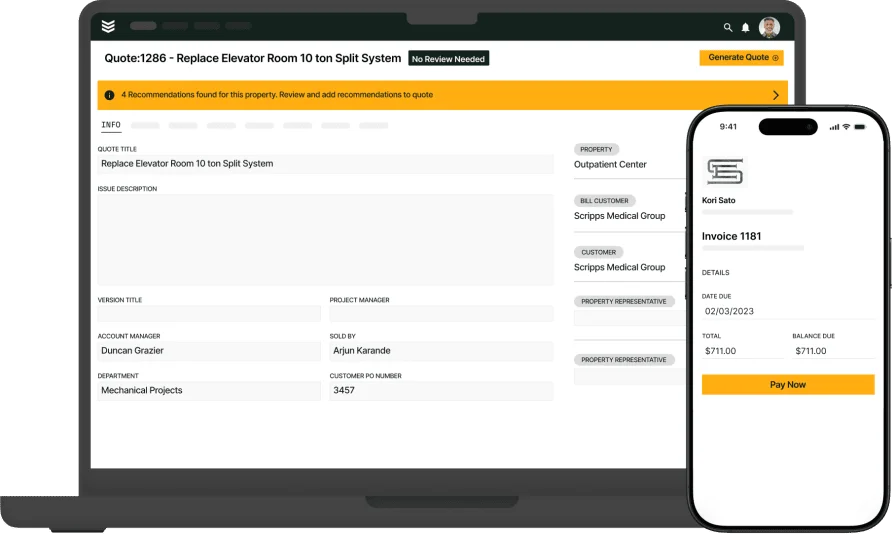
Curious if BuildOps is a good fit?
We’ll show you how we help commercial HVAC businesses land more jobs.







